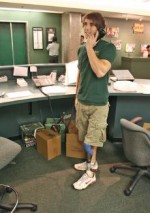New technology aids amputees

When 20-year-old Ronnie Dickson had his lower leg amputated more than two years ago, he was fitted for an artificial leg that couldn’t compare to the one he has today.
“It’s really about the closest thing (for me) out on the market to walking normally,” Dickson said.
Today, Dickson, a junior at USF, uses the C-Leg by Otto Bock, a prosthetic knee that adjusts as he walks using a microprocessor. Dickson said his new knee is a lot smoother than the last and is more versatile.
Advents in the field of prosthetics continue, however. USF’s School of Physical Therapy and Rehabilitative Sciences tested the Ossur Power Knee, a more advanced prosthetic knee that uses sensors to tell it how to move, in November.
Seven test subjects helped with the research study by using the Power Knee. Testing allows researchers to make improvements. Insurance companies may be more receptive to buying the product for their customers if they have proof of its effectiveness and its positive results, researchers say.
Dr. Michael Jason Highsmith, the project manager, says the Power Knee is the only prosthetic knee that offers power-assistance, which allows a prosthetic knee to operate similarly to a natural knee.
“There’s nothing close,” Highsmith said.
While previous technology, like the C-Leg, are more geared toward safety and falling, the Power Knee allows for more fine-tuned activities such as climbing stairs or rising from chairs.
“If you’re sitting in a chair with your knees bent to 90 degrees and you go to stand up, what’s happening at the knee is your leg is straightening,” Highsmith said. “That’s the power-assist feature; it will help to straighten the knee.”
Dickson’s first knee was a Total Knee 2000, a mechanical knee that lacked sensors or microprocessors. Mechanical legs, although approximately $20,000, cost about half of what a microprocessor knee does.
Dickson’s insurance policy covered the majority of the cost of his $56,000 C-Leg. He also uses an Aulie Knee, which is suitable for water sports and swimming.
And while the C-Leg is effective for walking down stairs and sitting down, it lacks the ability to move up stairs or get up out of chairs.
“The normal way for me to go up stairs is going one leg at a time,” Dickson said.
People without prosthetic limbs normally go up and down stairs by alternating their legs, which distributes weight evenly. For people with prosthetics, placing a lot of strain on the non-amputated knee can cause injury or arthritis.
“I just keep on doing my right leg over and over again,” Dickson said. “I go up one step, have my two feet on the step, then go up one more step.”
Researchers hope the Power Knee can help amputees avoid some of these adverse health impacts.
Sensors for the Power Knee are attached to the non-amputated leg at the ankle and inside the sole of a shoe. This way, the prosthetic can mimic the action of the other leg. There are also sensors inside the Power Knee itself so it can monitor the amount of weight being placed on it.
However, the Power Knee doesn’t know every step a person will take.
“Say, for example, you’re walking up to a set of stairs,” Highsmith said, “Well, it doesn’t know.”
In order to tell the Power Knee to walk up a set of stairs, the person has to do a series of movements to cue the action, he said.
“It’s very deliberate,” Highsmith said.
But unlike the C-Leg that Dickson uses, the Power Knee costs about $125,000, leaving insurance companies reluctant to cover the expense.
Highsmith hopes that by demonstrating how the Power Knee alleviates strain from the non-amputated knee, insurance companies will cover some of the cost.
“I think it’s safe to say at this point that it is helping to unload the knee,” Highsmith said.
The Power Knee is not designed for everyone, however. People who use the Power Knee should have a strong frame, as it weighs about 10 pounds. Children aren’t recommended to use the Power Knee.
Ossur also has a prosthetic foot, the Proprio Foot, which closely resembles a human foot, according to the Web site.
“The future would be to somehow combine the two technologies,” Highsmith said.
Although Dickson doesn’t have a Power Knee, he doesn’t use a prosthetic to participate in his latest hobby: rock climbing. He said he’d be interested in getting a Power Knee if insurance covered it, but was very happy with his C-Leg.






